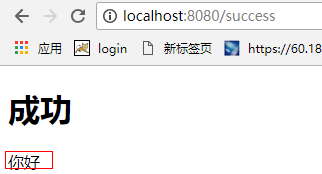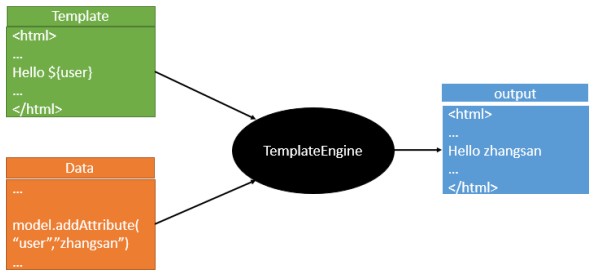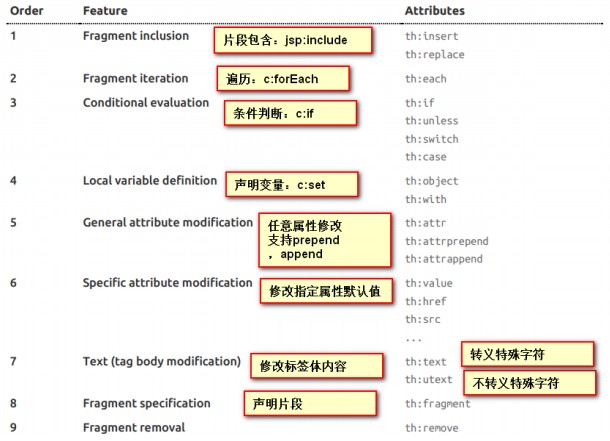SpringBoot模板引擎及原理
一、模板引擎的思想:
模板是為了將顯示與資料分離,模板技術多種多樣,但其本質都是將模板檔案和資料通過模板引擎生成最終的HTML程式碼。
二、SpringBoot模板引擎:
SpringBoot推薦的模板引擎是Thymeleaf——>語法簡單,功能強大。
1)、引入thymeleaf的starter啟動器。
<dependency> <groupId>org.springframework.boot</groupId> <artifactId>spring-boot-starter-thymeleaf</artifactId> </dependency> <!-- 預設版本號在parent的dependents中配置,如果要替換其中的版本,設定如下 --> <properties> <thymeleaf.version>3.0.2.RELEASE</thymeleaf.version> <!-- 佈局功能的支援程式 thymeleaf3主程式,適配layout2以上版本 --> <thymeleaf-layout-dialect.version>2.1.1</thymeleaf-layout-dialect.version> </properties>
2)、檢視thymeleaf的預設配置:進入ThymeleafAutoConfiguration的ThymeleafProperties配置檔案中,如下:
@ConfigurationProperties( prefix = "spring.thymeleaf" ) public class ThymeleafProperties { private static final Charset DEFAULT_ENCODING = Charset.forName("UTF-8"); private static final MimeType DEFAULT_CONTENT_TYPE = MimeType.valueOf("text/html"); public static final String DEFAULT_PREFIX = "classpath:/templates/"; public static final String DEFAULT_SUFFIX = ".html"; private boolean checkTemplate = true; private boolean checkTemplateLocation = true; //只要我們吧HTML頁面放在classpath:/templates/下就能夠自動渲染 private String prefix = "classpath:/templates/"; private String suffix = ".html";
3)、測試:建立controller如下:同時在templates資料夾下建立suceess.html與返回值相同。啟動後輸入:http://localhost:8080/success便可跳轉到success.html頁面。
@Controller
public class success {
@RequestMapping("/success")
public String success(){
return "success";
}
}三、thymeleaf使用
1)、匯入thymeleaf的名稱空間:就會具有thymeleaf的語法提示,不匯入也可以,只是麼有語法提示了。
<html lang="en" xmlns:th="http://www.thymeleaf.org">2)、寫一個簡單的demo上個手,如下controller層,給返回的頁面新增資料,如下:
@Controller
public class success {
@RequestMapping("/success")
public String success(Map<String,String> map){
map.put("hello","你好");
return "success";
}
}3)、開啟我們的靜態頁面success.html,根據thymeleaf模板引擎語法,獲取hello的值,如下:
<body>
<h1>成功</h1>
<div th:text="${hello}">
這是成功頁面
</div>
</body> 4)、需要注意的是:當hello有值時,顯示hello獲取到的值,如果單獨只訪問success.html時,只顯示前端頁面的內容 “這是成功頁面” 能夠非常友好的結合前後端進行程式設計。

四、thymeleaf語法規則:
1)、th:text:改變當前元素裡面的文字內容。語法文件:https://www.thymeleaf.org/doc/tutorials/3.0/thymeleafspring.pdf
th:任意html屬性:可以替換原生的HTML的元素。
2)、表示式語法:行裡表示式:[[xx]]—相當於th:text , [(xx)]—相當於th:utext
● Simple expressions:(表示式語法)
○ Variable Expressions: ${...}:獲取變數值,底層時OGNL;
1)、獲取物件的屬性、呼叫方法;
2)、使用內建的基本物件;#location...
3)、內建的一些工具物件;#strings...
○ Selection Variable Expressions: *{...}:選擇表示式,與${}的功能一樣,有一個不同,可以參考文件。
○ Message Expressions: #{...}:用來獲取國際化資訊
○ Link URL Expressions: @{...}:用來定義URL連線
○ Fragment Expressions: ~{...}:片段引入表示式
● Literals(字面量)
○ Text literals: 'one text' , 'Another one!' ,…
○ Number literals: 0 , 34 , 3.0 , 12.3 ,…
○ Boolean literals: true , false
○ Null literal: null
○ Literal tokens: one , sometext , main ,…
● Text operations:(文字操作)
○ String concatenation: +
○ Literal substitutions: |The name is ${name}|
● Arithmetic operations:(數學運算)
○ Binary operators: + , - , * , / , %
○ Minus sign (unary operator): -
● Boolean operations:(布林運算)
○ Binary operators: and , or
○ Boolean negation (unary operator): ! , not
● Comparisons and equality:(比較運算)
○ Comparators: > , < , >= , <= ( gt , lt , ge , le )
○ Equality operators: == , != ( eq , ne )
● Conditional operators:(條件運算)
○ If-then: (if) ? (then)
○ If-then-else: (if) ? (then) : (else)
○ Default: (value) ?: (defaultvalue)
○ Special tokens:
○ Page 17 of 106
● No-Operation: _:(特殊操作)3)、公共頁面抽取
<!--抽取公共片段-->
<div th:fragment="copy">
2011 The Good Thymes Virtual Grocery
</div>
<!--引入公共片段: ~{templatename::fragmentname} 片段 ~{templatename::selector} 選擇器-->
<div th:insert="~{footer :: copy}"></div>
<-- or -->
<div th:insert="footer :: copy"></div>
三種引入功能片段的區別:
▶ th:insert:將公共片段整個插入到宣告引入的元素中。
▶ th:replace:將宣告引入的元素替換成公共片段。
▶ th:include:將被引入的片段的內容包含進這個標籤中。
<footer th:fragment="copy">
2011 The Good Thymes Virtual Gro
</footer>
<!--引入方式-->
<div th:insert="footer :: copy"></di>
<div th:replace="footer :: copy"></div>
<div th:include="footer :: copy"></div>
<!--效果-->
<div>
<footer>
2011 The Good Thymes Virtual Grocery
</footer>
</div>
<footer>
2011 The Good Thymes Virtual Grocery
</footer>
<div>
2011 The Good Thymes Virtual Grocery
</div>4)、日期格式化:通過內建物件dates進行格式化。
<td th:text="${#dates.format(emp.birth,'yyyy-MM-dd')}"></td> 5)、 通過PUT請求提交資料:
● SpringMVC中配置HiddenHttpMethodFilter,(SpringBoot自動配置好)。
● 頁面建立一個post表單。
● 建立一個input項,name="_method",值就是我們指定的方式。
private String methodParam = "_method";
protected void doFilterInternal(HttpServletRequest request, HttpServletResponse response, FilterChain filterChain) throws ServletException, IOException {
HttpServletRequest requestToUse = request;
if("POST".equals(request.getMethod()) && request.getAttribute("javax.servlet.error.exception") == null) {
//重點:獲取_method傳過來的值
String paramValue = request.getParameter(this.methodParam);
if(StringUtils.hasLength(paramValue)) {
String method = paramValue.toUpperCase(Locale.ENGLISH);
if(ALLOWED_METHODS.contains(method)) {
requestToUse = new HiddenHttpMethodFilter.HttpMethodRequestWrapper(request, method);
}
}
}
filterChain.doFilter((ServletRequest)requestToUse, response);
}頁面實際操作:
<input type="hidden" name="_method" value="put" th:if="${emp}!=null">

